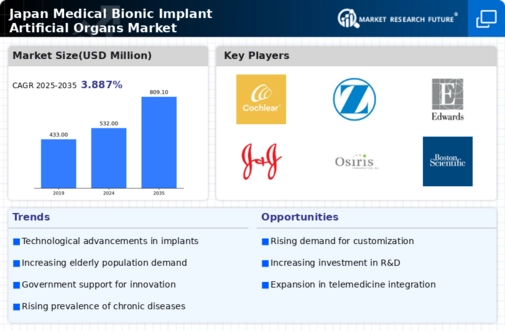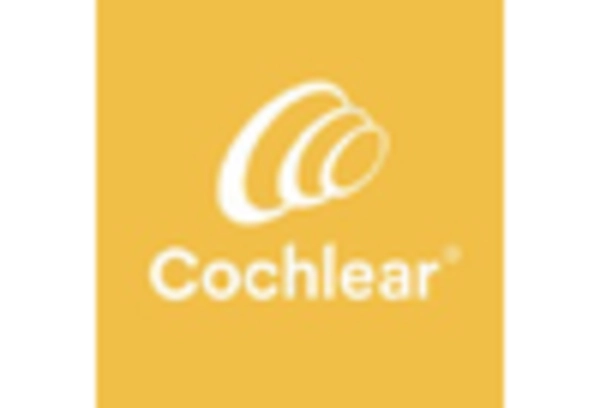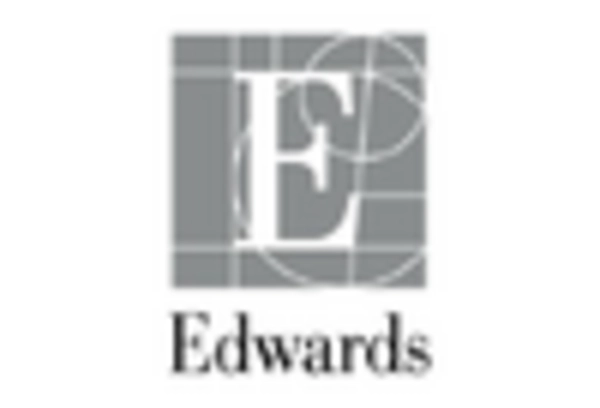Rising Healthcare Expenditure
The increasing healthcare expenditure in Japan is a pivotal driver for the medical bionic-implant-artificial-organs market. As the government allocates more funds towards healthcare, the demand for advanced medical technologies, including bionic implants and artificial organs, is likely to rise. In 2025, Japan's healthcare spending is projected to reach approximately $500 billion, reflecting a growth rate of around 3% annually. This financial commitment facilitates research and development in the medical bionic-implant-artificial-organs market, enabling innovations that enhance patient outcomes. Furthermore, the willingness of patients to invest in cutting-edge medical solutions indicates a shift towards prioritizing quality of life, thereby propelling market growth. The interplay between increased healthcare budgets and the demand for sophisticated medical solutions suggests a robust future for the medical bionic-implant-artificial-organs market.
Regulatory Support for Innovation
Regulatory support for innovation in the medical field is a critical driver for the medical bionic-implant-artificial-organs market. The Japanese government has implemented various initiatives aimed at fostering innovation in healthcare technologies. Streamlined approval processes for new medical devices and bionic solutions are encouraging companies to invest in research and development. In 2025, the regulatory framework is expected to become even more conducive to innovation, with anticipated reforms that facilitate faster market entry for advanced medical products. This supportive environment not only enhances the competitiveness of domestic companies but also attracts foreign investment in the medical bionic-implant-artificial-organs market. As regulations evolve to keep pace with technological advancements, the potential for growth in this sector appears promising.
Increasing Incidence of Chronic Diseases
The rising incidence of chronic diseases in Japan is a significant driver for the medical bionic-implant-artificial-organs market. Conditions such as diabetes, cardiovascular diseases, and renal failure are becoming increasingly prevalent, necessitating advanced medical interventions. According to recent statistics, approximately 30% of the Japanese population is affected by chronic diseases, leading to a higher demand for bionic implants and artificial organs. This trend is likely to continue, as the aging population further exacerbates the situation. The medical bionic-implant-artificial-organs market is expected to benefit from this growing need for innovative solutions that can effectively manage chronic health issues. As healthcare providers seek to improve patient outcomes, the integration of bionic technologies into treatment plans appears to be a promising avenue for addressing these challenges.
Technological Advancements in Medical Devices
Technological advancements play a crucial role in shaping the medical bionic-implant-artificial-organs market. Innovations in materials science, robotics, and bioengineering are leading to the development of more efficient and effective bionic implants and artificial organs. For instance, the introduction of biocompatible materials has improved the integration of implants within the human body, reducing rejection rates. In Japan, the market for medical devices is expected to grow at a CAGR of 5% from 2025 to 2030, driven by these technological breakthroughs. Additionally, advancements in artificial intelligence and machine learning are enhancing the functionality of bionic devices, allowing for personalized treatment options. This continuous evolution of technology not only meets the growing demand for advanced medical solutions but also positions the medical bionic-implant-artificial-organs market for sustained growth in the coming years.
Patient Awareness and Demand for Advanced Solutions
Patient awareness regarding the availability and benefits of bionic implants and artificial organs is steadily increasing in Japan. As individuals become more informed about their health options, the demand for advanced medical solutions is likely to rise. Educational campaigns and outreach programs by healthcare providers are contributing to this trend, highlighting the advantages of bionic technologies in improving quality of life. In 2025, it is estimated that around 40% of patients with chronic conditions will actively seek out bionic solutions, reflecting a growing acceptance of these technologies. This shift in patient attitudes is expected to drive the medical bionic-implant-artificial-organs market, as healthcare systems adapt to meet the evolving needs of informed patients. The interplay between patient demand and technological advancements suggests a dynamic future for the market.

















Leave a Comment